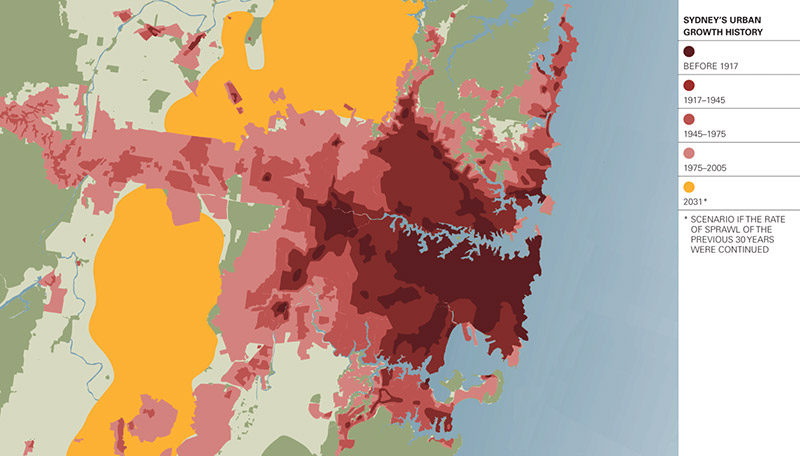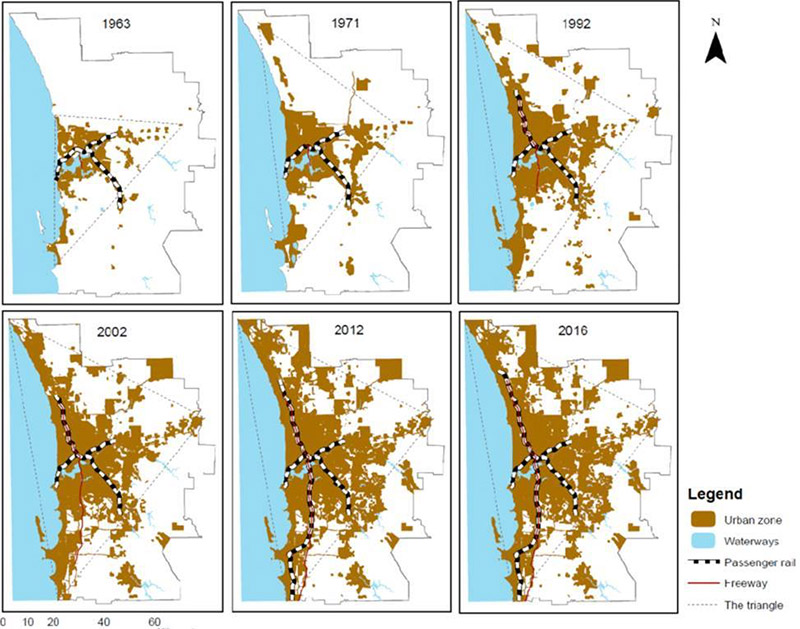Scale of urban sprawl in Australia hurting more than just the environment
Part One of API Magazine's two-part series on urban sprawl looks at how the seemingly unstoppable expansion of Australian cities is devastating the environment and proving costly for governments forced to support an insatiable demand for improved infrastructure, and offers insight into possible solutions to an ever-expanding issue.
“Sprawl is not good for our climate, and so we have to think about creating liveable density that allows us to take mass transit and take bicycles.
“How do we create affordable housing and mixed-use housing and how do we apply principles so that you're creating organic neighbourhoods?
“Frankly, some very well-intentioned laws and regulations at the local level, often generated from my own party, are sometimes inhibiting the creation of affordable housing and powering NIMBY (not in my backyard) attitudes and make it very difficult to integrate communities and allow people to live close to where they work.”

Part 2 - Urban Sprawl
Environmentalists and developers on their competing needs and search for common ground.
Former US President Barack Obama’s words, in describing a few weeks ago the blight of urban sprawl in the US, can just as readily be applied to Australia.
NIMBYism, political can-kicking, dire housing supply shortages, corporate self-interest, regulatory complexities and a lack of environmental prioritisation are all factors that have led to a seemingly unstoppable expansion of Australia’s major cities.
Perth now holds the dubious distinction of being the world’s longest city, Melbourne’s outer suburbs have exploded at the fastest rate of any state capital and ecologically important woodlands in Sydney are under immediate threat from urban sprawl.
The comprehensive Australia: State of the Environment 2021, released in July this year, stressed that population growth was set to continue indefinitely, putting greater pressure on major urban cities to densify as well as expand.
Written by independent and expert authors, the comprehensive report outlines the condition of the Australian environment, taking into account the pressures on it and the effectiveness of its management.
It paints a dire picture of environmental degradation and stated that “most of Australia’s eight major cities are growing at rates faster than many developed cities internationally”.
One of the report’s authors, University of Technology Sydney’s Senior Lecturer in Planning, Gabriela Quintana Vigiola, spoke to API Magazine about the scale of the urban sprawl issue and whether it was inevitable it would continue unchecked.
“Density is at the core of the issue,” Ms Quintana Vigiola said.

Source: Transport Sydney.
“Sydney is not even half as dense as most European cities.
“Urban sprawl is already here, but while it may appear unstoppable it could be limited with land protection policies and accompanying densification policies, which are not always politically favourable.
“It may be that we need to think that urban sprawl is not all bad in itself - it’s how we do greenfield development.
“We can do development well, including for example green areas in both public and private land, urban agriculture strategies, and better accessibility to services.”
Housing affordability issues have been ascribed to a lack of supply of new greenfield sites. The issue that arises is how policymakers and developers reconcile the need for continual housing supply with the impact on the natural environment of constant expansion.
“Housing affordability is much more complex than just land and housing supply, and even less about only greenfield development,” Ms Quintana Vigiola said.
“Having more and more houses is not the solution to housing affordability, just as building more roads doesn’t solve the traffic issue, it only worsens it.”
The expense of expansion
Constant urban expansion comes not only at an environmental cost, but also a financial cost.
Sergio Famiano, Senior Development Manager, LandCorp, and author of New Australian Dream: rethinking our homes and cities to solve the housing crisis, told API Magazine that population growth and car dependency were the primary drivers of unbridled urban expansion but political will and innovation could still minimise the scale and impact of sprawl in the future.
“Australian cities are car dependent and this means that housing for a growing population is accommodated largely through a suburban growth model that contributes towards urban sprawl,” Mr Famiano said.
“If larger urban populations can be accommodated in existing urban areas through infill development, this will limit the establishment of new suburbs and sprawl while at the same time accommodating a greater population.
“But there needs to be a policy shift by all levels of government in favour of urban infill development over new suburban development and this needs to be supported by the necessary infrastructure to encourage infill development, such as public transport.
“There is a strong nexus between mid-tier public transport such as light rail and trackless tram technology and the development of housing diversity such as apartment development.”
“Some difficult decisions need to be made on how we deal with urban sprawl.”
- Andre Jones, Director, Buchan
Mr Famiano pointed out that fringe suburbs often presented as more affordable housing but were encumbered by many more expenses for residents and taxpayers alike.
He said studies have shown that 10,000 people housed in existing urban areas costs a third of what is required in new suburbs.
“New suburbs on the fringe of our cities are expensive to build and are heavily subsidised.
“What most people don’t realise is that when you purchase a block of land in a new fringe suburb, you pay for the land, part construction of the local road and local park, and the services provided to the lot, like gas, sewerage, electricity, water.
“What you don’t pay for is the need for the freeway to be extended to support the new community, you don’t pay for the extension of public transport, you don’t pay for the new fire station, police department and school that is needed for the new suburb.
“All this infrastructure is largely paid for by the State Government through taxes but if new lot owners paid for this additional infrastructure, the price of lots on the fringe of our suburbs would increase dramatically.”
Mr Famiano said he didn’t believe suburban expansion could be stopped altogether.
“I do believe we can redress the balance of new development towards ‘urban consolidation,’ which would reduce the clearing of land in new suburbs and reduce urban sprawl considerably.”
Action versus inaction
As our cities expand and change, so too do their impacts.
As the State of the Environment report noted, “these include increased urban heat, congestion, pollution and waste, as well as growing pressure on our increasingly scarce resources such as water and energy.
“These impacts expand to the natural environment surrounding our urban areas and the biodiversity, green and blue spaces within them.”
Australia’s cities continue to grow at a faster rate than the regions, even in the wake of Covid.
“The proportion of Australians living in higher-density dwellings such as units and townhouses continued to grow, consistent with state and territory targets for greater infill development,” the report said.
“However, since the pandemic, our growing appreciation of space and demand for larger homes has led to a move away from apartment living towards more suburban and regional opportunities, supported by greater rates of working from home for some.”
The housing crisis that has seen rents soar and vacancy rates plummet to historic lows in most capital cities has led to greater calls for increased housing supply.
In New South Wales, the Greater Cities Commission has recognised the scale of the problem and has sought to address it through housing solutions in, rather on the outskirts of, cities.
“A lack of housing diversity means there is often a mismatch between supply and demand for types of housing,” the Greater Cities Commission’s Discussion Paper noted.
“There is a need to enable choices while maximising affordability, including for our most vulnerable community members and this can happen by providing a full range of homes, from single dwellings with granny flats, dual occupancies and townhouses and low-rise apartments through to larger-scale mixed use development in thriving local and strategic centres.”
The outline sets targets for housing to be delivered in locations within 800 metres of a strategic centre or transport hub. A minimum goal has been set to provide 25 per cent of Local Government Area (LGA) housing through a mix of higher density housing types (e.g. apartments, townhouses, and boarding houses).
In Perth, Andre Jones, Director of Buchan, is overseeing the design of WA’s $1 billion 20-year project at Cockburn Quarter for Perron Group, and said more incentives were needed for developers to redress urban sprawl.
“Over the past 10 years, an enormous amount of groundwork has been done to transform Perth into a truly modern Australian city, and more so, an international city,” he said.
The spread of Perth

“However, some difficult decisions need to be made on how we deal with urban sprawl in Perth’s northern and southern corridor.
“How do we deal with the expanding metro and infill development? How do we densify what we have at the moment? How do we do that to best suit our growth plan?
“The pieces are slowly falling into place and some great planning strategies have come into play.
“We now have community title legislation and government is looking at planning reform that removes the ‘nimby’ debate, but for one reason or another there is a lack of actual construction happening.
“At this point no one wants to be ‘first down the mine’ with community title — some form of incentive needs to be found to inject development.
“No one wants to be first and the public needs to be educated on the benefits of community titles.
“Once that happens, and we find appropriate incentives, I think it will be the avalanche that causes us to rethink how we build our city and metro areas,” Mr Jones said.
Lofty ambitions, mixed outcomes
Maxwell Shifman, National President of the Urban Development Institute of Australia (UDIA), said greenfield development is a vital and necessary part of the Australian housing mix and there will always be a need for some proportion of growth.
“The fact is that new suburban developments are planned to be far from the disconnected urban sprawl of old – that is, they plan for active transport, significant open spaces, and substantial localised facilities and amenities which mean these new areas are far more self-contained, localised, and less reliant on the nearest CBD.”
But he acknowledged that ambitious targets do not always translate into outcomes.
“All of our major cities have had key planning strategies aimed at increasing densification within existing areas for decades, which is a positive policy for many reasons.
“For example, Plan Melbourne has a stated aim of seeing 70 per cent of new dwelling growth in established areas and 30 per cent in greenfield areas.
“But despite these lofty goals, the reality is the complete reverse, and it is only getting more skewed towards new greenfields.”
Meanwhile, the Federal Government has just announced that it wants to build another million new homes to address the housing supply shortage.
Whether these dwellings will be created in the city or by ploughing more bushland is yet to be seen.
Andrew Clugston, Partner at business advisory firm Pitcher Partners in Melbourne, said the Housing Accord talks about expediting zoning and planning but offers no detail.
“There are still significant opportunities to develop infill sites in Melbourne, but the issue is the lack of coordination between the state government strategy and the council implementation.
“Ideally infill sites would make up a lot of the new housing, given it will be close to employment and public transport infrastructure.”



















